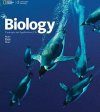About this book
In the new edition of Biology: Concepts and Applications, authors Cecie Starr, Christine A. Evers, and Lisa Starr have partnered with the National Geographic Society to develop a text designed to engage and inspire. This trendsetting text introduces the key concepts of biology to non-biology majors using clear explanations and unparalleled visuals. While mastering core concepts, each chapter challenges students to question what they read and apply the concepts learned, providing students with the critical thinking skills and science knowledge they need in life.
Renowned for its writing style the new edition is enhanced with exclusive content from the National Geographic Society, including over 200 new photos and illustrations. New People Matter sections in most chapters profile National Geographic Explorers and Grantees who are making significant contributions in their field, showing students how concepts in the chapter are being applied in biological research. Each chapter concludes with an ‘Application’ section highlighting real-world uses of biology and helping students make connections to chapter content.
New to this edition:
- The new edition of Biology: Concepts and Applications was developed in partnership with the National Geographic Society, an organization known for eye-opening photography and a legacy of inspiring people to care about biology and the environment that supports it. The result is a text that combines clear explanations with unparalleled visuals to bring core concepts into focus.
- New People Matter sections in most chapters profile National Geographic Explorers and Grantees who are making significant contributions in their field, showing students how concepts in the chapter are being applied in their biological research.
- Each chapter concludes with an ‘Application’ section highlighting real-world uses of biology and helping students make connections and deepen understanding of concepts.
Contents
INTRODUCTION
1. Invitation to Biology
Part I: PRINCIPLES OF CELLULAR LIFE
2. Life's Chemical Basis
3. Molecules of Life
4. Cell Structure
5. Ground Rules of Metabolism
6. Where It Starts-Photosynthesis
7. How Cells Release Chemical Energy
Part II: GENETICS
8. DNA Structure and Function
9. From DNA to Protein
10. Control of Gene Expression
11. How Cells Reproduce
12. Meiosis and Sexual Reproduction
13. Observing Patterns in Inherited Traits
14. Human Inheritance
15. Biotechnology
Part III: PRINCIPLES OF EVOLUTION
16. Evidence of Evolution
17. Processes of Evolution
18. Life's Origin and Early Evolution
Part IV: EVOLUTION AND BIODIVERSITY
19. Viruses, Bacteria, and Archaeans
20. The Protists
21. Plant Evolution
22. Fungi
23. Animals I: Invertebrate Groups
24. Animals II: The Chordates
Part V. HOW PLANTS WORK
25. Plant Tissues
26. Plant Nutrition and Transport
27. Plant Reproduction and Development
Part VI. HOW ANIMALS WORK
28. Animal Tissues and Organ Systems
29. Neural Control
30. Sensory Perception
31. Endocrine Control
32. Structural Support and Movement
33. Circulation
34. Immunity
35. Respiration
36. Digestion and Human Nutrition
37. Maintaining the Internal Environment
38. Reproduction and Development
Part VII: PRINCIPLES OF ECOLOGY
39. Animal Behavior
40. Population Ecology
41. Community Ecology
42. Ecosystems
43. The Biospheres
44. Human Effects on the Biosphere
Appendix I: Periodic Table of the Elements
Appendix II: Amino Acids
Appendix III: A Closer Look at Some Major Metabolic Pathways
Appendix IV: A Plain English Map of the Human Chromosomes
Appendix V: Restless Earth-Life's Changing Geologic Stage
Appendix VI: Units of Measure
Appendix VII: Answers to Self-Quizzes and Genetics Problems
Glossary
Index
Customer Reviews
Biography
For the past two decades, Cecie Starr has been known as one of the best-selling biology textbook authors. Her texts, appreciated for their clarity in both the written word and the visual representation of biological concepts, include multiple editions of Biology: The Unity and Diversity of Life, Biology: Concepts and Applications, and Biology Today and Tomorrow. Her original dream was to become an architect. Instead of building houses, she now builds, with care and attention to detail, incredible texts based on this philosophy: "I invite students into a chapter through an intriguing story. Once inside, they get the great windows that biologists construct on the world of life. Biology is not just another house. It is a conceptual mansion. I hope to do it justice."
Christine Evers has been creating multimedia and Web-based materials to supplement Starr and other science texts for ten years. She earned her B.S. in Biology from SUNY Stony Brook. After working as a research assistant studying the developmental biology of slime mold, she was awarded an N.S.F. fellowship to attend Yale, where she studied evolutionary biology and honeybee behavior. She has a strong interest in science education and serves as a member of her local school board.
Lisa Starr earned her B.A. in Chemistry/Biochemistry from the University of California at San Diego Revelle College in 1982. Over the next five years, she became expert in molecular and cell biology as she helped build a veterinary virology research program at the startup biotech firm Syntro (which was later spun off into Protein Polymer Technologies). During this time, Lisa invented the cDNA cloning kit and the mRNA isolation kit that launched Invitrogen (now part of Life Technologies). She left Syntro to launch a molecular biology division for a veterinary vaccine company (Synbiotics, later acquired by Pfizer Animal Health), and then spent seven years at The Scripps Research Institute investigating integrin isoform expression in development and cancer metastasis and training postdoctoral candidates. She was recruited to start up the biotech firm Ixsys/Applied Molecular Evolution (later acquired by Lilly) and to establish proof-of-concept for combinatorial library construction as well as antibody randomization/humanization at the fledgling firm. Prior to joining the Starr franchise, she was recruited to start up Desmos, another biotech firm, that was later spun off into Cythera/Novocell/ViaCyte. Since 1997, Lisa has been responsible for the incredible art in the Starr biology textbooks, and began authoring the books in 2004.


























